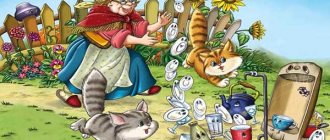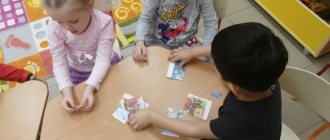Card index of games based on fairy tales
Progress of the game:
A fairy tale is chosen for adults (this may be a fairy tale that is currently being studied). The presenter takes one of the heroes of the fairy tale and describes him: he tells how he looks, good or evil, big or small, what he does during the fairy tale, etc. After that, he asks the children to repeat what he said.
Then the presenter takes another figurine and asks the children to take turns describing the hero and make sure that the descriptions are not repeated.
If this does not work, the presenter asks leading questions: for example, what is the grandfather wearing; is he old or young; what he does, etc. For correct answers, the child receives a token. The one who gives the most answers wins.
"Find by silhouette."
Purpose of the game: Development of speech, visual thinking, attention, figurative memory.
Material: figures of heroes from one fairy tale are used (“Turnip”, “Teremok”, “Kolobok”, “Hare and Fox (Zayushkina’s hut)”, etc.). You can use figurines of fairy-tale characters from the theater on flannelgraph.
Progress of the game:
The presenter asks the children to look at the figures from all sides. Next, he explains what a silhouette is and asks the children to trace the silhouette of the figure with their finger, and then with a pencil.
The presenter lays out the figures on the reverse side and asks them to find fairy tale characters and objects.
“Show me the same.”
Purpose of the game: Expand vocabulary. Teach children mental operations: comparison, generalization, logical thinking. Develop imagination, be able to classify objects according to different criteria.
Material: figurines of fairy tale characters from the theater on flannelgraph; pictures with plots of the chosen fairy tale.
Progress of the game.
The presenter talks about how there are identical objects, body parts in different people, animals, etc., and asks the children to show the same things.
Then he asks to answer his questions and show the same on the figures. For example, who has tails, who is dressed in skirts, how are grandfather, grandmother, granddaughter (they walk on their feet, people) similar, how are bugs, cats, mice (animals) similar, etc.
“Color according to the description.”
Purpose of the game: development of speech, the ability to listen to others, clearly express your thoughts; consolidation of the concept of “silhouette”; development of observation, imaginative thinking and imagination.
Material: figurines of fairy tale characters from the theater on flannelgraph; pictures with scenes from the game “Collect and tell a fairy tale”, the selected fairy tale; riddles for fairy tale heroes; colored pencils, paper.
Progress of the game.
The presenter tells the children a fairy tale and lays out supporting pictures with the plots of the fairy tale. Then, together with the children, he selects figurines of fairy tale heroes.
When the figures are in front of the children, an adult reads a riddle about one of the heroes from a card. Children must guess who we are talking about. The one who guessed first becomes the storyteller.
Five educational literary games for children
There are many educational literary games for children - for different ages, oral and written, short and time-consuming. The main benefit of such games is the development of creative abilities, speech, memory, and logical thinking.
In addition, these games help keep children occupied with interesting and useful activities in circumstances where nothing else is available. We will talk about short games designed for children 6–12 years old.
Vitaly KAPLAN: “I have been working with literary gifted children for more than twenty years, I lead several children’s literary studios, and I also teach journalism classes with children from a scout troop. And during this time, I have accumulated knowledge that can be useful to teachers, parents, and even older brothers and sisters of elementary school students.
We are talking about games that children play with pleasure, but which not only entertain, but also develop. Some of these games can be used in the company of children, and some can be played with one or two children. An important point: an adult should not simply give a task to the children and silently watch how they cope: he himself needs to become a participant in such a game.
The names of the games are conditional, you can come up with something else.
"Chattering"
This game, as I heard, is traditionally used in training young journalists. A journalist sometimes has to not only write texts, but also broadcast live. And every pause, hesitation on the air is a disaster. Therefore, you need to learn to speak without pauses, quickly select words to express your thoughts. This is what the game teaches.
The game requires several participants - preferably at least three, but, in extreme cases, you can play together. The presenter (who himself participates in the game) pronounces several phrases related in meaning. For example: “There are many stars and planets in space, some planets are similar to Earth. There could be life there - plants, animals... all sorts of animals and birds..."
He stops at the word “birds” and nods to one of the children. He should begin his speech with the word “birds”. Say whatever you want, maybe stupid, but not a meaningless set of words, but logically connected. For example, a child says: “Birds are big and small, there are birds that fly, and there are flightless ones, for example, ostriches. Ostriches are big, but their heads are small, and they have beautiful feathers.”
The child was about to say something further, but the presenter cuts him off at the word “feathers.” The next participant should speak from this word. For example, he will say: “Feathers were once used for arrows when shooting from a bow. The arrow flew quickly and could pierce enemy armor. Then they shot from bows and crossbows, because guns had not yet been invented.” The presenter stops him on the word “guns”, and the next participant starts with this word. And so on in a circle. If the participant has absolutely no idea what to say, then he skips the move.
What word should you stop at? It’s better to use one with which children have some lasting associations, about which they have something to say. For example, “cat”, “house”, “resentment”, “star”. It’s probably not worth stopping at the words “worldview”, “laboratory” or “revolution” (and in children’s speech there may be words that are not very clear to them). I usually focus on nouns, but, in principle, it is possible on verbs and adjectives.
The order (who speaks after whom) is established in advance. Usually in a circle.
When should I end this game? Depends on the number of participants (it is advisable that everyone has time to speak at least two or three times). And in any case, for children of primary school age, it is not worth spending more than 15 minutes on this game; their attention will already dissipate.
"Memory book"
This game is more creative, here the child already has to strain his imagination. But, in addition, it also develops memory.
Here, too, several participants are desirable - but not very many, no more than five or six. The game begins with the leader saying a short phrase, which the next participant must repeat out loud and continue with his own phrase. Logically connected. For example, the presenter says: “A hungry cat was walking down the street.”
The next participant says, for example: “A hungry cat walked down the street. She was kicked out of the house and had nothing to eat.” The third says: “A hungry cat walked down the street. She was kicked out of the house and had nothing to eat. She dreamed that someone would feed her.”
Fourth: “A hungry cat was walking down the street. She was kicked out of the house and had nothing to eat. She dreamed that someone would feed her. And then one boy gave her a sausage in dough”... Each next participant must say everything that was said before him and add his own phrase.
The game ends when it becomes difficult for children to remember everything that was said earlier, when they begin to get confused. Then the adult presenter, when it’s his turn, makes the final move: he pronounces the entire previously composed story and ends it with his last phrase. For example: “And from then on the cat was happy.”
Here, too, it is advisable not to play for more than 15 minutes. However, it may happen that the children get carried away by the story they are composing, and then they need to be given the opportunity to finish composing until they get tired (and if they get tired, it is always very noticeable).
"Collective composition"
This game, unlike the “memory book,” does not require each participant to repeat everything previous, due to this, children can come up with longer phrases. And everything else happens the same way: the leader gives the initial phrase, the next participant gives his continuation, the next one continues further.
Moreover, if the children are not very young (from 9–10 years old), you can play the game in a written format - they can write their phrases in a predetermined order on the board (if there is a board) or on a piece of paper. That is, the history they compose must be recorded.
If the children are still small and it is still difficult for them to write quickly, but they already know how to read, then the presenter should write down their phrases (on the board or on paper). If possible, it is also good to record the process of this collective composition on video or audio.
By the way, you can play this way with two people. For example, a parent and child together make up a story - each using their own phrase. If you play together, you can deviate from the rules and give the child the opportunity to compose not just one phrase, but as many as he can right away.
But if you have a group of children, then you cannot allow such a long stream of imagination - because against the backdrop of super-creative children, others may get bored. Here you need to clearly moderate: from everyone - a phrase. And if nothing comes up, then the move is skipped.
And also in terms of time, this game should be limited to 15 minutes - except for the situation when one child is playing with one adult, there is enough time and the flow of children's creativity cannot be stopped. Then - until the child gets tired.
"Individual composition"
This is already closer to what is called an etude in working with literary gifted children, that is, performing a creative task.
Such a game can be carried out both in oral and written format - depending on the age of the participants, and if their ages are very different, then older children can work in writing, and younger ones can compose in their heads and then tell it orally.
Children are given the same task. For example, compose a story or fairy tale that begins with a given (pre-selected!) phrase. Let’s say “The Serpent Gorynych really didn’t like brushing his teeth, but Baba Yaga forced him every morning.” Time is given (15–20 minutes), and everyone comes up with their own version of how this story can be continued.
Five minutes before the end of the set time, children need to be reminded that there are five minutes left and to move towards completion. After the time has passed, they begin reading out loud what they have written. Just readings, without discussion, without criticism.
It is advisable to also record this reading on video, and it is very important to do this when young children orally recite what they have composed mentally. Kids usually like the very fact of such a recording; it gives significance to their activity in their eyes.
After everyone has read what they came up with, an adult can speak out on these stories, note their strengths, and give some advice for the future. You cannot criticize or point out shortcomings! This is not Lit. a studio where seriously motivated children come, but just a game. However, such games are also played in literature classes. studios, and there critical analysis is quite acceptable.
It is worth recalling that if the game is played in writing, then the presenter must take care in advance of the availability of paper and pens and pencils. Otherwise, a lot of time will be spent searching for what to write with and what to write on.
"Selection of adjectives"
This game is no longer closer to literary creativity, but to mastering the Russian language. You can play with one child, or you can play with a group of children (in the latter case, an element of competition is introduced into the game). Here it is desirable that all children participating are the same age, and it is better if they are younger. For children 10–12 years old, this game may no longer seem so interesting.
The game consists of the fact that the presenter gives the children some kind of noun (if possible, it should be written large on the board or on something that will be clearly visible to the children). And the children take turns (I remind you that the order of priority must be established in advance, otherwise there will be shouting and confusion) offering adjectives that fit this noun.
Moreover, if the game is played with a group of children, then somehow it is necessary to record which of the children suggested which adjective. For example, if you have a board or a large sheet of paper, you can draw a table like this:
The winner is the one who comes up with the most different adjectives (different - that is, describing different qualities, so white, black, red will count for one position, as well as small and large).
In principle, you can simplify the task for children by allowing them to use not only adjectives, but also participles. Especially if the children are small enough and do not yet know how to distinguish participles from adjectives.
It is very good if the participants in the game do not just shout out their proposals from their seats, but come up to the board or a piece of paper (which can be taped to the wall) and write their own options. Moreover, in controversial cases, they must justify their choice, that is, explain why, for example, the adjective “dazzling” can be applied to the word “cat”.
You can also diversify this game by giving the task to come up with adjectives for a given word that are absolutely not suitable for it. For example, in the case of the noun cat, we could have a table like this:
You can allocate more than 15 minutes for such a game, but the number of participants is critical here. If there are too many of them (for example, 10–15 people), then many children simply will not have time to say anything, because when it’s their turn, all the options lying on the surface will already be taken.
And also, unlike previous games, here it is better for the presenter not to participate himself. His knowledge and erudition will give a decisive advantage, and the children will feel the injustice. However, the presenter here does not just silently observe and record children’s proposals, but also comments and shows which options are more expected and which are non-standard.
Finally, I will repeat: there are many literary and language games, I only talked about those that I most often use to work with primary schoolchildren. There is also a lot of literature on this topic, a lot of different developments from both professional teachers and ordinary parents. There are many online resources describing similar games. And besides, you can come up with such games yourself. And best of all, together with your children.”
We recommend reading:
L. Malysheva, “Play with words” // M., “Knowledge”, 198
E. Sinitsyna, “Clever words” // M., “List”, 1997
“Savvy for kids” // M., “Omega”, 1994;
S. Fedin, “The best games with words” // M., “IRIS PRESS”, 1999;
T. Rick, series “Funny Textbooks” // M., “Samovar”, AST
Vitaly Kaplan
Website of the magazine "Foma"






